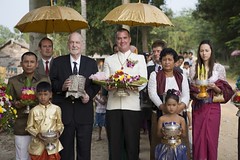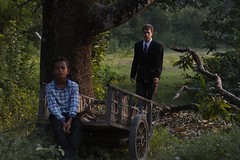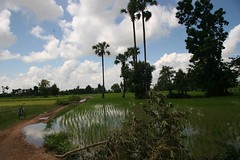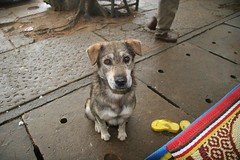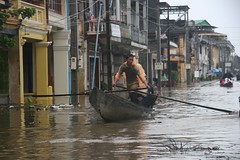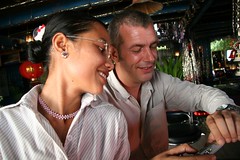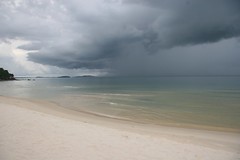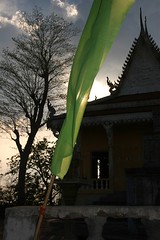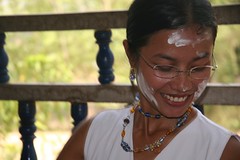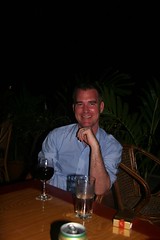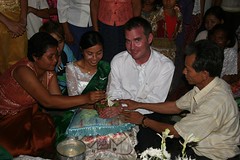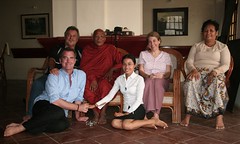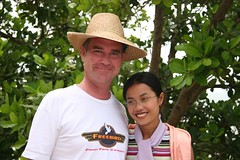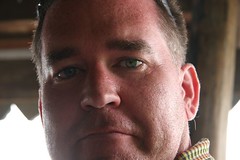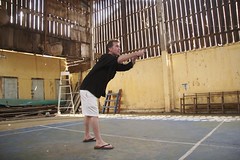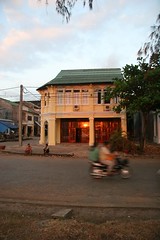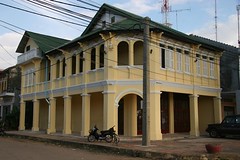The groom and his family deliver gifts to the bride's family.
Monday, November 13, 2006
Monday, November 06, 2006
Thursday, October 12, 2006
faulty towers
January 4th 2006. Martin had suggested we take the newly paved road to Kep instead of the main route 3. This turned out to be an excellent suggestion as the road passes close to the elephant mountains and the road was smooth with little traffic. We stopped in Kep, at the Veranda, for a bite to eat around 3pm. When we reached Kampot the staff at the hotel had been alerted to our visit and they gave us a quick tour. Dusty furniture was piled up with big metal signs and loads of trash in the foyer. The place smelled bad. The water wasn’t working (the pump needed replacing) so the rooms were not ready to stay in. We went off in search of a hotel. A helpful moto-dop lead us to all the hotels he gets commissions from. We ended up at the Boray Bokor II hotel. A fairly new four story place that had hot water and air con for $20/night. The rooms still managed to be shabby and the staff were less than helpful. The next morning I asked the front desk for some coffee, they said they didn’t have any, so I asked if there was someplace near-by to have breakfast. They replied that yes, there used to be a place right across the street but it closed a few months ago. Anyplace that’s open? They looked at each other and shrugged. We went back to the Bokor Mountain Club and went through it again with some of the old staff that were still on the FCC payroll; Mr Punsavaan, the accountant, Mr Kunsavaan, the night guard, Tula (the old bartender) and Vitu, the day guards. I made rough sketches of the rooms and what was missing or needed fixing and took photos. We asked Tula about the boat that the FCC supposedly owned and he replied that it was docked across the river. We decided to go look at it. He described the road to take and that it was a long open hull fishing boat painted light blue. We followed his directions, drove over the bridge and then turned left, over a smaller bridge. Every boat was painted light blue and there were dozens moored there. We took a quick look at a pagoda that overlooked the river then decided to drive out towards the entrance to Bokor Mountain National Park. We missed the turn off and were about a third of the way to Sihanoukville when we turned back. It was 5pm when we stopped back at the BMC. Rather than spend another disappointing night at the Boray we booked a night at the Champrey Inn in Kep (mainly because it had such a nice photo in the guidebook of its pool). We had an excellent meal, and a very engaging conversation with the proprietor, Nicolas. How do I put this diplomatically? I was engaging Nicolas in conversation about ancient Rome, global warming, satellite imagery, Khmer history, and boutique hotel management, while Eric was still contemplating how to react to the frenchman’s Khmer husband. Eric was polite in the end but he was conspicuous in his fishing for strategically useful information (land values, potential competitors in Kampot, government contacts, etc.).
Thursday, October 05, 2006
unemployment uninsurance
I used to work for a big corporate photo lab in LA. They handled all the big defense contractors and some movie studios. I started in order-entry but then moved up to black and white contact printer. The machine printers were pretty unique - big contraptions that sucked long rolls of photo paper through all the chemical baths and then dried and cut them into 8x10 glossy prints of head shots or experimental aircraft. At photography school I had learned to dodge and burn on graded archival paper using strict formulas for developing times and temperatures, none of which was required to run this machine. The guy who used to run the machine was an old timer who had been moved to the color roll printer because Lockheed had a big order for color glossies of it’s new stealth fighter. He trained me before he started the Lockheed job. The main things to worry about were paper jams and dust. I liked the job because when I was in the darkroom, if I turned on the safelight, a little red light went on outside the door forbidding anyone from entering my private space. I would listen to the gulf war on NPR and doodle. The place was thick with chemical fumes and it was too dark to read but no one, not even the boss, could enter when that red light was on. Jobs would be delivered to order entry by the in-house drivers. Then they would go to the repro department, unless it was a reprint job. Repro would turn the original image into an 8x10 neg and deliver it to me. I started work at ten, but most jobs wouldn’t get to me until after noon. This meant most nights I was working overtime. As time went by I started coming in later to work and my overtime disappeared. Three months went by, the Lockheed job was done - delivered to the congress and the press, and my mentor was let go. He was fired just before he was eligible for his retirement benefits. I was notified of this only after I went looking for him to help me with a particularly fucked up paper jam. They had the nuts to call him at home to ask him to talk me through the problem. He was noble enough to help me but I felt dirty. I was due for my yearly review (and expected raise) but they postponed it, explaining that my next review would be one year from the day I started as a printer ( having moved from customer service to production). I objected and they agreed to give me a review in six months. Some time later we got a big job from McDonnell/Douglas (another stealth fighter). Now they asked me to do the color contacts as well. I kept my overtime down by coming in late but I was still exhausted - they had us coming in on saturdays! My review came up. I went into it expecting a 25 cent an hour raise - the same as my previous reviews in order entry. They told me I was doing a great job but because I was late so often they were only going to give me a ten cent an hour raise. They also asked me to start training someone from order entry to run the contact machine. I did my best to explain their depravity and gave my two weeks notice. They offered my a 25 cent raise but I refused. They offered me a fifty cent raise. I told them if they wanted a loyal employee they shouldn’t have fired my mentor. I meant to point out that if I had accepted the raise I would be first in line at the next downsizing. They told me they needed me to finish the McDonnell/Douglas job and to train my replacement, so I agreed to give four weeks notice. Some months later I applied for unemployment insurance. They explained that I was not eligible because I had quit my job. Up to that point in my life I had no idea what unemployment insurance was, nor had I ever expected to need it. I explained that I quit because I was about to be downsized and I wanted to make a statement. I said that I quit because I was constantly exposed to hazardous fumes. I said I quit because my employers were cretinous fuckheads. They explained that I was not eligible because I had quit my job and my ex-employer has the last word on that.
I was reminded of this period in my life when recently my old employees at the Lodge have all been fired or quit and have come to me looking for work or a loan.
I thought about the economics of the unemployed. If jobs were plentiful and you could easily quit and find another job or have some expectation of insurance (that you had been paying dues on) until you found a better job, then managers and owners would have to actually work to keep things running smoothly. Most employees don’t slag off or steal or sabotage unless they have reason to. That reason is poor management. Managing a company is a cakewalk if your employees act like slaves because they are afraid they cannot put food on the table.
I was reminded of this period in my life when recently my old employees at the Lodge have all been fired or quit and have come to me looking for work or a loan.
I thought about the economics of the unemployed. If jobs were plentiful and you could easily quit and find another job or have some expectation of insurance (that you had been paying dues on) until you found a better job, then managers and owners would have to actually work to keep things running smoothly. Most employees don’t slag off or steal or sabotage unless they have reason to. That reason is poor management. Managing a company is a cakewalk if your employees act like slaves because they are afraid they cannot put food on the table.
Friday, September 29, 2006
letter to the editor
Do Cambodians have freedom of Religion?
The article by D. Gillison in the Cambodia Daily on Sep. 18 shows some alarming statistics which deserve proper and deep analysis.
If we consider that Cambodia has 13 million inhabitants then the statistics show:
Population # of Pagodas/
Churches/Mosques # of worshippers per place of worship
Buddhist 93% 12,090,000 4163 (59%) 2904
Christian 2% 260,000 2400 (34%) 108
Muslim 5% 650,000 500 (7%) 1300
It is surprising that Christians, who represent 2% of the population, have 2400 churches or 34% of the total number of places of worship in Cambodia. Massive financial support from Christian groups from abroad fund the recent surge of church construction. Fundamentalist churches from the USA and Korea are very rich and very active in Cambodia. Today, these churches may not be well attended, but the objective is to use them as examples of successful proselytization, conversion, dissemination of the faith, to solicit money from believers back home. They show off the new buildings as examples of the church’s money well spent ‘saving souls’. These souls are mostly children. Children are happy to attend church meetings because they are given food and treats. During the children’s programs, adults and parents are not allowed to join or observe, so they don’t understand what is going on. Most Buddhists would assume that charity comes without the expectation of conversion yet these churches don’t give without also sermonizing. It is easier to manipulate a child’s mind than an adult’s. This will have grave consequences for Khmer society if families are divided; children becoming Christian while their elders remain Buddhist.
Cambodian leaders should be concerned about the threat that these fundamentalist groups pose to Khmer culture and society. Cambodian Buddhism is still recovering from the dark days of the Khmer Rouge. Khmers born between 1970 and 1993 have very little exposure to Buddhism, and as adults cannot teach important Buddhist values to their children. In Laos, Thailand, Burma, and Sri Lanka, where Buddhism is strong, there is less of a risk to the children. The Christian proselytizers are often ignorant of the damage they do to Khmer culture, focusing instead on the appearance of successful conversions to raise more money to continue their exploits here.
Freedom of Religion is a Human Right because it defines freedom of thought. Bribing poor children with treats and food to convert them to an alienating religion is not compatible with freedom of thought. Selling radio and television time to evangelicals is corrupt and corrupting. Christians do not have a monopoly on morality. Buddha lived and taught centuries before Christ, and in-deed many of Jesus’ best teachings bear a great similarity to the clarity of the Dharmapada. Perhaps it is the Cambodians who should be converting these guests to the Way.
“When the missionaries arrived, the Africans had the land and the missionaries had the Bible. They taught us to pray with our eyes closed; when we opened them, they had the land and we had the Bible.”
-Jomo Kenyatta, 1952
We know now that the soul is the body, and the body the soul. They tell us they are different be-cause they want to persuade us that we can keep our souls if we let them make slaves of our bodies.
-George Bernard Shaw
The article by D. Gillison in the Cambodia Daily on Sep. 18 shows some alarming statistics which deserve proper and deep analysis.
If we consider that Cambodia has 13 million inhabitants then the statistics show:
Population # of Pagodas/
Churches/Mosques # of worshippers per place of worship
Buddhist 93% 12,090,000 4163 (59%) 2904
Christian 2% 260,000 2400 (34%) 108
Muslim 5% 650,000 500 (7%) 1300
It is surprising that Christians, who represent 2% of the population, have 2400 churches or 34% of the total number of places of worship in Cambodia. Massive financial support from Christian groups from abroad fund the recent surge of church construction. Fundamentalist churches from the USA and Korea are very rich and very active in Cambodia. Today, these churches may not be well attended, but the objective is to use them as examples of successful proselytization, conversion, dissemination of the faith, to solicit money from believers back home. They show off the new buildings as examples of the church’s money well spent ‘saving souls’. These souls are mostly children. Children are happy to attend church meetings because they are given food and treats. During the children’s programs, adults and parents are not allowed to join or observe, so they don’t understand what is going on. Most Buddhists would assume that charity comes without the expectation of conversion yet these churches don’t give without also sermonizing. It is easier to manipulate a child’s mind than an adult’s. This will have grave consequences for Khmer society if families are divided; children becoming Christian while their elders remain Buddhist.
Cambodian leaders should be concerned about the threat that these fundamentalist groups pose to Khmer culture and society. Cambodian Buddhism is still recovering from the dark days of the Khmer Rouge. Khmers born between 1970 and 1993 have very little exposure to Buddhism, and as adults cannot teach important Buddhist values to their children. In Laos, Thailand, Burma, and Sri Lanka, where Buddhism is strong, there is less of a risk to the children. The Christian proselytizers are often ignorant of the damage they do to Khmer culture, focusing instead on the appearance of successful conversions to raise more money to continue their exploits here.
Freedom of Religion is a Human Right because it defines freedom of thought. Bribing poor children with treats and food to convert them to an alienating religion is not compatible with freedom of thought. Selling radio and television time to evangelicals is corrupt and corrupting. Christians do not have a monopoly on morality. Buddha lived and taught centuries before Christ, and in-deed many of Jesus’ best teachings bear a great similarity to the clarity of the Dharmapada. Perhaps it is the Cambodians who should be converting these guests to the Way.
“When the missionaries arrived, the Africans had the land and the missionaries had the Bible. They taught us to pray with our eyes closed; when we opened them, they had the land and we had the Bible.”
-Jomo Kenyatta, 1952
We know now that the soul is the body, and the body the soul. They tell us they are different be-cause they want to persuade us that we can keep our souls if we let them make slaves of our bodies.
-George Bernard Shaw
Monday, September 18, 2006
redundancy
To call someone a fat twat in Cambodia is redundant, because twat is the khmer word for fat.
motodop manners
When you want to tell a moto taxi that you have had a pleasant ride on the back of his moped, tell him, “I enjoyed my heinie”. This will let him know you appreciated the extra bit of duct tape he put on the metal seat you rode on, and the care he took when driving through every pothole at full speed. If he replies, “Joy my heinie?!”, you can reply, “Enjoy my heinie, away!”.
Please read comments for disclaimer...
Please read comments for disclaimer...
Thursday, September 07, 2006
Sunday, August 27, 2006
Thursday, August 17, 2006
kampot flood
We went up to the rapids to visit the river, the next day the river came to visit us... The river was still 5 feet below its banks at sundown, although it was running very fast - I tried to call Hugh to ask him what he thought of the current but his phone wasn't ringing ( he had lost it in the river). We were awoken at 5 the next morning when our landlady called to tell us the river was flooding. Sure enough, in the grey, rainy morning we could see that the river was 4 feet over its bank and lapping at our door. The street in front of our house was a fast moving current of deep water. Within a few minutes the power was out. We tried to get sand bags and plastic to keep the rising water at bay but no one was selling. Our neighbors had enough dirt and plastic to keep the water out for a little while before they had to put all their furniture on their car (which they jacked up), they have only a single story house so they asked us to store some of their valuables in our second story. We moved most of the furniture upstairs, balanced the fridge on some chairs, put bricks under the large tables and cabinet. Makeshift boats were floating by at this point. Several large trees fell into the street and three large fishing boats dropped anchor right at our front door. The entire town was under water. I waded around taking pictures. Hugh's entire place (the Bodhi Villa) was underwater - he had evacuated his parents and guests by boat. The roads were all closed so we had to put off the trip to the embassy.Please see photos - more later
Monday, August 14, 2006
Thursday, July 27, 2006
contemporary events
Whenever I watch CNN, Spohea asks me if the news is ‘live’, and I say ‘yes’ and she says ‘then why is it always the same?’ Israel has been in the news a lot recently and Sophea has been asking me a lot of questions. I give what I think are good generalities in response but she has still more questions. So I decided to use pirated DVDs to explain the whole history of the middle east to her. I chose “The Merchant of Venice” with Al Pacino, and “The Pianist” directed by Roman Polanski. So now Sophea is all caught up and can analyze the situation as well as the best pundits a pound of flesh can buy.
Tuesday, July 18, 2006
Saturday, July 15, 2006
ongoing saga
It is time to give a full accounting of my recently ended association with the Bokor Mountain Lodge. I will start at the very beginning. When I lived in Phnom Penh in 1994, working as a photo archivist at the Tuol Sleng genocide museum, I frequented a restaurant called the DéjaVu, on Street 240 just next to the Royal Palace. Sitting on the balcony you could look over the high yellow wall into the compound and see armed Khmer Rouge soldiers milling about. They had been given sanctuary by the King who was trying to broker a peace treaty with them and the newly formed (UN installed) CPP/FUNCINPEC government. The restaurant was run by Antony and Kelly, a brit and a kiwi. At this time there were only a handful of western run eateries and of the few that I frequented (the Cafe No Problem, the FCC, the Wildcat, the Rock Hard Cafe) the DejaVu was by far the nicest, both in ambiance and quality of food. This is how I know Antony.
During this time travel to the coast, either Sihanoukville or Kampot, was prohibitively dangerous. Three friends of Kelly’s were abducted and killed traveling down route 4. Several NGO workers were held for ransom by the Khmer Rouge. Kampot remained dangerous for another six years, with various backpackers being kidnapped and killed.
A few years later Antony took over the FCC, and made it the special place it is today. He has a real love of the old colonial architecture and aside from making it a really comfortable establishment he always had the best trained staff and he took very good care of them.
My nine months in Phnom Penh will be permanently etched in my mind and will only be described through my fictional writings as the reality was indeed stranger than fiction. I returned to Cambodia several times but it was in 2005 that I finally visited the coast. I took the bus to Sihanoukville, suffering from an eye infection, and spent 5 days at Occitali Beach. Then I took a cab to Kampot. I stayed at the Bokor Mountain Club, knowing it was operated by the FCC. I stayed in a really shitty room (room #3) for $15 / night. But I was pleasantly enchanted by the location and the employees. I met a good friend and fellow writer, Ioannis, visiting from KL, whom I am still in correspondence with. The bartender was a charming young Khmer named Tula and his infectious smile went a long way to alleviate the smelly bathroom and the loss of my favorite white shirt to their laundry service. He saw my Apple laptop and told me about his old manager, Paul, who had the same computer and would hook it into the stereo to play music. As the bar was only playing Khmer music I offered to hook up my iTunes and it greatly improved the ambience of the place. I told him as I was leaving that I would be back one day and be his manager.
I returned to Cambodia in August of 2005 with a half finished novel in my mind. I took a container ship across the Pacific to Tokyo to spend the nine days writing. After a week in Tokyo and a few days in Osaka I took the ferry to Shanghai. After a week there I flew direct to Phnom Penh. I stayed the first few days at the FCC. I met Antony there and asked if he could help me find an apartment. He called Sam who had an apartment just down the street above Hurley’s Cantina. It was a long treacherous stair climb, but the apartment was nicely furnished and had a great view of the river. Sam said he would give me a special deal, $350/ month as I was an old friend. I wasn’t sure if this were true until I learned later that the apartment had been renting for $400 and after I left it was again renting at $400. Sam also introduced me to one of his employees, Nith, a young man who worked at the Rendezvous Restaurant and spoke excellent English. Nith spent a day helping me get a cell phone and would not accept any money from me. He was interested in my work at Tuol Sleng and invited me to a seminar at his university. The seminar was about the future of Cambodia, but it did address ways to reconcile with the past, Nith suggested I speak about what should be done with the museum at Tuol Sleng, as I had been telling him that it should not be treated like a tourist attraction and that if it were to continue as a museum it needed to include more contextual information, not just gruesome titillation and old Vietnamese propaganda. I missed the deadline for submitting my thesis to the seminar (it would have cost me $10 to speak).
During this time I spent a lot of time reconnecting with old friends. I spent some time talking with Antony about the people we knew back in ’94 and the changes in the city. I mentioned enjoying my stay at the Bokor Mountain Club and expressed my intent to live in Kampot to write my novel. He told me the hotel had been closed for almost a year and that I could rent it for $400/ month. I thought at the time that he was kidding but later I asked Paul, who used to manage the Club, and he said Antony was probably serious. A little later I asked Antony if it were still on offer, but he said someone had already made an agreement. Paul introduced me to Eric, Antony’s uncle (in law) and after becoming friends I learned that Eric had intended to rent the BMC, but was having second thoughts. He had already taken the step of having the exterior repainted for $2400. It was at this stage that his negotiations with Antony had stalled. Eventually, Antony and Eric and I were all sitting at the FCC when the BMC came up again. Antony suggested that he would help Eric open the hotel and that they should hire me to be an ‘artist in residence’ to keep an eye on things. Eric still wanted Antony to reimburse him for the cost of the painting, but Antony thought Eric had paid too much. Eric asked me to look over some documents Antony had given him; old spread sheets from the BMC, memos, ect ... I told Eric it seemed a viable opportunity and suggested that I might be able to raise some money to go in with him as equal partners. I figured if I could get $5000, and he put up another $2600, we could get the place up and running. I even went so far as to make some spread sheets of my own, based on the old numbers from the BMC and therefore most likely underestimating the potential traffic as Kampot was quickly becoming more accessible while the rest of Cambodia was rapidly reaching a tourist saturation point. I also put together a rough estimate of the start up costs, keeping them under $10k. I should note that one of the striking things about the memos was that the action points remained the same from one year to the next, as if nothing had been accomplished.
There were occasional stories about Kampot in the Cambodia Daily, mostly about an ex-pat American who ran a small cafe and had a web site promoting euthanasia. He was encouraging people to come to Kampot to off themselves as there were no laws against it (not true) and it was easy to get the vodka, vallium and plastic bags that he recommended as a release from this mortal coil. There was a movement to get him deported. This increased when a British woman, suffering from terminal illness, died of an overdose of vallium and vodka in her guesthouse in Kampot. It is likely that if she had done the same in a advanced country she would still be alive as all she needed was to have her stomach pumped. In Kampot if you are sick or dying the only thing they can do is give you an IV drip (glucose) and send you on the 3 hour drive to PP where you will probably die of some complication in Calamity Hospital. So there was some bad publicity about Kampot, but nothing that would deter tourists. I would recommend anyone considering suicide come to Cambodia, but not because it is legal or easy to off one’s self, but because a few weeks here should be enough to make you appreciate whatever life you have. And if you remain suicidal, just walk around Phnom Penh at night, someone will do you a favor.
Eric had the use of a Hyundai Land-Monster SUV, so we drove down to see the condition of the hotel. As we drove out past the airport a land-mine went off in a nearby field. Hopefully just a cow. We felt the shock-wave and then saw the plum of smoke.
During this time travel to the coast, either Sihanoukville or Kampot, was prohibitively dangerous. Three friends of Kelly’s were abducted and killed traveling down route 4. Several NGO workers were held for ransom by the Khmer Rouge. Kampot remained dangerous for another six years, with various backpackers being kidnapped and killed.
A few years later Antony took over the FCC, and made it the special place it is today. He has a real love of the old colonial architecture and aside from making it a really comfortable establishment he always had the best trained staff and he took very good care of them.
My nine months in Phnom Penh will be permanently etched in my mind and will only be described through my fictional writings as the reality was indeed stranger than fiction. I returned to Cambodia several times but it was in 2005 that I finally visited the coast. I took the bus to Sihanoukville, suffering from an eye infection, and spent 5 days at Occitali Beach. Then I took a cab to Kampot. I stayed at the Bokor Mountain Club, knowing it was operated by the FCC. I stayed in a really shitty room (room #3) for $15 / night. But I was pleasantly enchanted by the location and the employees. I met a good friend and fellow writer, Ioannis, visiting from KL, whom I am still in correspondence with. The bartender was a charming young Khmer named Tula and his infectious smile went a long way to alleviate the smelly bathroom and the loss of my favorite white shirt to their laundry service. He saw my Apple laptop and told me about his old manager, Paul, who had the same computer and would hook it into the stereo to play music. As the bar was only playing Khmer music I offered to hook up my iTunes and it greatly improved the ambience of the place. I told him as I was leaving that I would be back one day and be his manager.
I returned to Cambodia in August of 2005 with a half finished novel in my mind. I took a container ship across the Pacific to Tokyo to spend the nine days writing. After a week in Tokyo and a few days in Osaka I took the ferry to Shanghai. After a week there I flew direct to Phnom Penh. I stayed the first few days at the FCC. I met Antony there and asked if he could help me find an apartment. He called Sam who had an apartment just down the street above Hurley’s Cantina. It was a long treacherous stair climb, but the apartment was nicely furnished and had a great view of the river. Sam said he would give me a special deal, $350/ month as I was an old friend. I wasn’t sure if this were true until I learned later that the apartment had been renting for $400 and after I left it was again renting at $400. Sam also introduced me to one of his employees, Nith, a young man who worked at the Rendezvous Restaurant and spoke excellent English. Nith spent a day helping me get a cell phone and would not accept any money from me. He was interested in my work at Tuol Sleng and invited me to a seminar at his university. The seminar was about the future of Cambodia, but it did address ways to reconcile with the past, Nith suggested I speak about what should be done with the museum at Tuol Sleng, as I had been telling him that it should not be treated like a tourist attraction and that if it were to continue as a museum it needed to include more contextual information, not just gruesome titillation and old Vietnamese propaganda. I missed the deadline for submitting my thesis to the seminar (it would have cost me $10 to speak).
During this time I spent a lot of time reconnecting with old friends. I spent some time talking with Antony about the people we knew back in ’94 and the changes in the city. I mentioned enjoying my stay at the Bokor Mountain Club and expressed my intent to live in Kampot to write my novel. He told me the hotel had been closed for almost a year and that I could rent it for $400/ month. I thought at the time that he was kidding but later I asked Paul, who used to manage the Club, and he said Antony was probably serious. A little later I asked Antony if it were still on offer, but he said someone had already made an agreement. Paul introduced me to Eric, Antony’s uncle (in law) and after becoming friends I learned that Eric had intended to rent the BMC, but was having second thoughts. He had already taken the step of having the exterior repainted for $2400. It was at this stage that his negotiations with Antony had stalled. Eventually, Antony and Eric and I were all sitting at the FCC when the BMC came up again. Antony suggested that he would help Eric open the hotel and that they should hire me to be an ‘artist in residence’ to keep an eye on things. Eric still wanted Antony to reimburse him for the cost of the painting, but Antony thought Eric had paid too much. Eric asked me to look over some documents Antony had given him; old spread sheets from the BMC, memos, ect ... I told Eric it seemed a viable opportunity and suggested that I might be able to raise some money to go in with him as equal partners. I figured if I could get $5000, and he put up another $2600, we could get the place up and running. I even went so far as to make some spread sheets of my own, based on the old numbers from the BMC and therefore most likely underestimating the potential traffic as Kampot was quickly becoming more accessible while the rest of Cambodia was rapidly reaching a tourist saturation point. I also put together a rough estimate of the start up costs, keeping them under $10k. I should note that one of the striking things about the memos was that the action points remained the same from one year to the next, as if nothing had been accomplished.
There were occasional stories about Kampot in the Cambodia Daily, mostly about an ex-pat American who ran a small cafe and had a web site promoting euthanasia. He was encouraging people to come to Kampot to off themselves as there were no laws against it (not true) and it was easy to get the vodka, vallium and plastic bags that he recommended as a release from this mortal coil. There was a movement to get him deported. This increased when a British woman, suffering from terminal illness, died of an overdose of vallium and vodka in her guesthouse in Kampot. It is likely that if she had done the same in a advanced country she would still be alive as all she needed was to have her stomach pumped. In Kampot if you are sick or dying the only thing they can do is give you an IV drip (glucose) and send you on the 3 hour drive to PP where you will probably die of some complication in Calamity Hospital. So there was some bad publicity about Kampot, but nothing that would deter tourists. I would recommend anyone considering suicide come to Cambodia, but not because it is legal or easy to off one’s self, but because a few weeks here should be enough to make you appreciate whatever life you have. And if you remain suicidal, just walk around Phnom Penh at night, someone will do you a favor.
Eric had the use of a Hyundai Land-Monster SUV, so we drove down to see the condition of the hotel. As we drove out past the airport a land-mine went off in a nearby field. Hopefully just a cow. We felt the shock-wave and then saw the plum of smoke.
Tuesday, June 06, 2006
Tuesday, April 25, 2006
Wednesday, April 19, 2006
Kampot New Year
I was happy to see Jon Smith arrive in Kampot. He brought lots of goodies from home and seems to understand my love of this place. I took him and Martin to see Jasmine's family for the new year celebration and he seemed to really enjoy the experience. He is making progress on his fetch-a-phrase project. On Saturday we all took a boat ride to the Bodhi Villa to watch the fire works that were mostly aimed at our boat or the river. Jon tried to ride our rented Moped after Jas was too tired to drive us all home from dinner and Martin showed him how to shift gears but forgot to show him how to break. Jon drove straight at the wall of the courtyard and was saved greivious bodily injury by a wood pile and some laundry. The Moto was a little fucked up but Jas was able to drive it home, Martin took his bike and Jon and I walked home. It was 3000 riel to repair the bike (75 cents).
The workers are back at it with the bathrooms and Jon has been helpfull in drawing plans for the countertops and showing his exasperation at the shoddiness of the workmanship (which I have become quite used to - even enomoured with.
Fun this evening iChatting with folks back in the states: Galen and Tai.
It is raining like all fuck now.
The workers are back at it with the bathrooms and Jon has been helpfull in drawing plans for the countertops and showing his exasperation at the shoddiness of the workmanship (which I have become quite used to - even enomoured with.
Fun this evening iChatting with folks back in the states: Galen and Tai.
It is raining like all fuck now.
Thursday, April 13, 2006
bathroom renovation
I am renovating the bathrooms at the hotel. Mr Hey Guy is going to install the new urinal I bought from Mr Pissat. I am not making this up. Now all work has stopped as it is Khmer New Year. The work will resume on the 17th.
Monday, March 27, 2006
Tuesday, March 14, 2006
Friday, March 10, 2006
Friday, February 24, 2006
Friday, February 17, 2006
good help is hard to find
After You left I got Mad. Mad is the electrician. Then D asked La to send over Da to set up the internet. He got it working, then he said he would send me the bill by email. he said they would turn off the service until they were paid. As he was leaving I asked how I could get the bill by email if the service was turned off. He thought for a moment and then said he would deliver the bill personally. I shouted for Joy, as he passed on his moto. He, as luck would have it, has been looking after Lucky’s pipes. So I had Joy to look at my shower. He recommended a water pressure pump. I showed Mao how to sand the new shelves by doing half of them myself. Then he took over and did half the rest of the job. I then had to decide whether to have a massage by Touch or Ouch across the street at “Massage by the Blind $4/hour”. I hired a carptinter to do the bar shelves, his name is Nok. They don't know what carpinters are; they call them 'woodmen'. So play with that one.
Sunday, February 12, 2006
how much do I owe You?
I had to fire our contractor before he had finished painting the insides of the hotel. He was doing a terrible job and a lot of local expats said he was overcharging and he simply could not understand why we wanted him to pull out the mold infested 1/8” plywood ceiling in room six; he wanted to paint over it. So we had to figure out how much of the job was done and how much we owed him. This was the most stressful day I’ve had in Kampot. He was convinced he was 90% done. I would be generous in suggesting that he was almost halfway done. The main problem arose as he started painting room six before he had finished downstairs. Room six requires a total gutting, not just for the mold but the electrics are all fucked and the floor is sinking. He seemed to think it was amusing that I insisted on taking down the plywood, and I decided to fire him. It was just down to negotiating a price for the shoddy job he had already completed. The original contract for all the indoor painting was $2100. We had given him a $400 deposit to start the work. I asked my manager to find out how much the paint cost ($380) and how much his workers were paid per day ($5 for the supervisor, $.75 for the others) and I began to get an idea of what was going on. They had worked four days, sometimes only two or three workers, never on time, long lunches, and off by five. They splattered paint on the tile floors, ruined a lot of furniture which they used instead of ladders (even though I loaned them my new ladder), poured paint down our drain (clogging it) and didn’t mask off any of the light fixtures. So he wants $1000 on top of the deposit. We have our “fixer” Mr Sovaan, an ex KR who was doing the books for the FCC mediate and he keeps taking the contractor’s side, saying we had agreed to pay and he was almost done. I was smiling all the time, explaining that we needed to finish the electrics before we painted and just needed to sort the expenses. Long story short, we agreed to pay $500 and let them take the remaining paint. The contractor’s name is Mr You. So I owe You nothing...
another bridge story
When Paul was visiting with his girl Vero, one of his old drivers stopped by the hotel. Paul was the manager of the BMC for two years and everyone knows him. So he introduces me to this Khmer that used to drive guests up to the top of Bokor Mountain in the BMC’s 4 wheel drive. He didn’t speak much english and Paul said he was probably insane, but also that he was the last person to destroy the bridge in Kampot. He set the charges and blew the bridge as the KR were about to take Kampot. I had always assumed that the B52’s had taken out the bridge back in ‘69. Now it just needs an overloaded salt truck...
Monday, February 06, 2006
Tuesday, January 31, 2006
Sunday, January 29, 2006
too much salt
Kampot is famous for its pepper and salt. Ecky and I woke early and headed to the FCC for coffee and to meet our 4 ton rental truck. It was late. We hired five moto-dops to load the truck with all the kitchen equipment that the FCC had been storing from the old Bokor Mountain Club. They threw in some big frames and a cash-register and some other stuff. Then we drove to the apartment and loaded al the boxes of linens and curtains and t-shirts. The truck was barely half full. We grabbed an AC unit and the electrician and sent it all down to Kampot. Then we went and picked up Ant at his house. We drove south through Kandal and then onto national route 3. We took the new road that passes through Kep. After two and a half hours we were nearing Kampot. Fifteen kilometers to go and the traffic slows, a tour bus is parked by the side of the road and a lot of people are crowding the middle of the road up ahead. Tourist are carrying their bags up from a little dirt side road to the tour bus. Traffic stops. Cars are turning around. We ask what’s going on. “Bridge out”. Is there another way around? They gesture back the way we came. “Route 3”. The road we were on connects with route 3 about half way back to Phnom Penh, and from there it would be again as far to Kampot, about 180 k total. The motos and bikes and tourists were being ferried across the river on fishing boats (500 riel). We turn around and head back the way we came. I consult the map ( a German map) and see a small connecting road from Kampon Trach 30 k direct to route 3. So we stop in Kampon Trach and buy some beers. We ask about how to get to Kampot, they point down the way we came. We explain that the bridge is out. They don’t believe us. Finally they say we must go back to route 3. We ask about the dirt road, “No, very bad road.” So we take the dirt road. It was only 30k to route 3, past some really beautiful country and some very stunned locals. But it was also a “very bad road” and we made about 30k/h. When we finally made it to Kampot the truck (which we had zoomed past a few k outside of PP) was waiting for us. It was then that we learned what had happened to the bridge. It was a long bridge and it had a big hole in it that traffic had to navigate around. A big truck full of salt took the left hand way around this hole and the whole section of bridge just flipped over pitching the truck into the drink. The truck driver was held for questioning and will most likely be blamed by the government.
Monday, January 23, 2006
Why Is Everybody Going to Cambodia?
By MATT GROSS
JUST after Christmas in 1859, the French explorer Henri Mouhot left Bangkok to explore the uncharted regions of Indochina. It took him a year of hacking through brush and fending off leopards, leeches and wild elephants before he arrived at Angkor Wat, the jungle-smothered complex of temples deep inside the kingdom of Cambodia. Less than two years later, he died of malaria.
What took Mouhot a year can now be accomplished in little more than an hour, via Bangkok Airways' seven daily flights from the Thai capital to Siem Reap, home base for Angkor expeditions. Mouhot may have had to trudge three hours down a sandy path through dense forest to reach the ruins, but 21st-century visitors have the luxury of everything from tuk-tuks to Land Cruisers to an AS-350 Squirrel helicopter.
And while Mouhot lamented the temples' abandonment, today they are such popular tourist attractions that the measure of an expert Angkor guide is not his knowledge of Hindu and Buddhist cosmology, nor his mastery of English, French and Japanese, but his ability to show visitors the most popular sites - the Bayon, Phnom Bakheng, Ta Prohm and Angkor Wat itself - and have them wondering, at day's end, "Where was everybody else?"
But not all guides are expert at deftly avoiding the tourist crush, and there are frequently days when it seems everybody is in Cambodia. In 2004, international arrivals topped one million for the first time, a figure reached in 2005 by the end of September, according to the Ministry of Tourism.
In almost every part of the country, you can find a conceptually and architecturally ambitious hotel: In mountainous Ratanakiri, there's the Terres Rouges Lodge, a former provincial governor's lakeside residence that has, Time Asia said last July, "the best bar in the middle of nowhere." On the Sanker River in Battambang, Cambodia's second-largest city, there's La Villa, a 1930 house that in October opened as a six-room hotel filled with Art Deco antiques. And sometime this summer, you should be able to head south to Kep and stay at La Villa de Monsieur Thomas, a 1908 oceanfront mansion that's being transformed into a French restaurant ringed with bungalows.
And then there is Angkor Wat. Foreign visitors are flooding in - 690,987 paid entrance fees last year, up from 451,046 in 2004. And while there are no official figures as to how much each spends in Siem Reap, the town's dizzying array of luxury hotels - at least 10 by my count, ranging from the Raffles Grand Hotel d'Angkor to quirky boutiques like Hôtel de la Paix - testifies to the emergence of a new generation of high-end travelers, who not only demand round-the-clock Khmer massage but are also willing to pay $400 a day to hire a BMW L7 or $1,375 an hour for a helicopter tour.
Cambodia is not alone in its luxury revolution. Since the mid-1990's, the former French colonies of Southeast Asia have made enormous leaps in catering to tourists who prefer plunge pools to bucket showers. From the forests of Laos to the beaches of Vietnam to the ruins of Cambodia, you can find well-conceived, well-outfitted, well-run hotels that will sleep you in style for hundreds of dollars a night.
DESPITE all the changes in Cambodia, the immigration desk at Siem Reap International Airport remains a bastion of indifference. When I passed through in October, 10 officials sat behind the visa counter, wordlessly gazing at a mob of tourists, who were hurriedly filling in application forms, fumbling for passport photos and $20 bills, and in the absence of any signs or personnel to direct them, wondering where to go next.
Outside, however, it was a different story: A guest assistant from Hôtel de la Paix carried my bag through the parking lot - past a new terminal designed to handle 1.5 million passengers a year when it opens this summer - to a Lexus S.U.V. As we drove into town, listening to Morcheeba on the car's iPod Mini, the driver and I discussed development on the airport road: I could remember when it had few hotels and restaurants; he could remember when it had none.
At la Paix, an artfully serene white palace designed by the landscape architect Bill Bensley, another assistant led me into the expansive arts lounge, where I sipped fresh orange juice and split my attention between the movie "Indochine," which was being projected on the wall, and the youthful staff members, who moved about with a surprising sureness of purpose.
Soon, an assistant took me to my room - dark woods, creamy fabrics, functioning Wi-Fi and another iPod - and cheerfully helped me plan my stay: a trip to Angkor Wat (with an "excellence guide," he wrote on his notepad) and, almost as important, a local SIM card for my cellphone ("first thing in the morning"). I wandered to the second-floor pool, which flowed like a river from the spa and down to the courtyard, at whose center grew a knotty ficus. Everywhere: calm. The hotel was aptly named.
This was a Cambodia so far removed from the one I'd encountered when I first visited, in March 1997, that I began to wonder if I was even in the same country. Back then, Cambodia was the Wild West, with Phnom Penh its Deadwood. My hotel was the Morakat, which had two room-service menus, one for food, the other for girls. My spa treatment was an unceremonious ear-cleaning at a Vietnamese-run barber shop. (I still have nightmares.) I dined on streetside fried noodles and went to a pitch-black nightclub, where a friend and I were shown to our table by a tuxedoed midget with an enormous flashlight.
Oh, and the day after I arrived, unidentified assailants threw grenades into a crowd of 200 people demonstrating outside the National Assembly, killing at least 16 and injuring more than 100.
To say that Cambodia has come a long way is to state the obvious. Gone are the Khmer Rouge, the Vietnamese occupation, the United Nations democracy-restoration period and the era of warring prime ministers (the current prime minister, Hun Sen, came out on top in 1997). Angkor Wat has been swept clean of land mines, and it is generally safe to travel city streets at night.
When I visited Siem Reap in December 1999, it was far from bustling, and visitors to the temples could climb atop the rubble of Ta Prohm unbothered by security guards. The Grand, which dates back to 1932, had been renovated and reopened by the Raffles Group only two years before, and Angkor Village was the resort for in-the-know tourists and expatriates who wanted something nicer than a guesthouse.
Now more than 100 hotels serve tourists of all budgets. The Grand has been joined by a Sofitel, Le Meridien and the Sokha Angkor. On the boutique side, Angkor Village must now contend with la Paix, La Résidence d'Angkor, the FCC Angkor, the Shinta Mani and an Aman resort, the Amansara. By the end of this month, the One Hotel plans to open its doors - or, rather, its door: There's just one room, a duplex with flat-screen TV, iBook, Wi-Fi and a whirlpool.
These changes are perhaps hardly surprising, given Angkor Wat's popularity and the increasing adventurousness of luxury travelers.
"People want to take their lifestyle and life standard with them," said Grant Thatcher, the publisher of Luxe City Guides, a series of directories to chic treats in Asia. "People don't want to just sit in a flea-bitten rat hole and get eaten by mosquitoes."
His guides - to silversmiths in Bali, Dutch colonial antiques in Sri Lanka, orchids in Bangkok - are fast becoming indispensable for their up-to-date intelligence (each is reissued every six months) and cheeky, Daily Candy-in-Hong Kong voice. (On the Metropole, in Hanoi: "This grand old Gertie has finally got off her colonial bum and begun an upgrade.")
Luxe does not yet offer a Cambodia guide, but the entrepreneurs of Siem Reap are doing their best to prepare for it. Want to see Angkor Wat by hot-air balloon? No problem. Is $1 too little to pay for a krama, the traditional Cambodian checked scarf? A crinkly silk boutique version can run more than $50. Want your entire stay videotaped, then edited into a feature-length film? Just ask the One's front desk.
It's in the realm of culture that Siem Reap really excels, and to a degree that would be surprising in any tourist locale, let alone one dominated by one of the greatest and most perplexing artistic achievements of all, Angkor Wat. On weekends there are cello concerts, and in December "Les Nuits d'Angkor," a blend of ballet and traditional Khmer dance, takes place in front of the temple itself. My October stay coincided with the Angkor Photography Festival, a week of exhibitions, workshops and exclusive soirées.
Just add a soothing glass of pastis, and it's easy to imagine you're in a hub of sophistication, shuttling between cocktail parties, fancy restaurants and gallery openings with a crowd of like-minded travelers. Except that everywhere in Siem Reap - and throughout Cambodia - are reminders of the country's wretched history, crushing poverty and political mismanagement. Take two steps outside your hotel, and you'll find people sleeping in the streets, some of them missing limbs. (Still, there are fewer today than in the past.)
Corruption is rampant. Villagers are routinely evicted at gunpoint from their land by the wealthy and well-connected, critics of Hun Sen's policies are liable to find themselves imprisoned, and the leader of the small political opposition, Sam Rainsy, who organized the tragic 1997 demonstration, lost his parliamentary immunity a year ago and fled the country to escape defamation charges; last month, a court convicted him in absentia. The belief among many foreigners living in Cambodia is that this constitutional monarchy is really a totalitarian kleptocracy, its officials enriching themselves at the expense of aid organizations (which heavily subsidize the government's budget), not to mention the long-suffering Cambodian people.
Which makes it all the more stunning and delightful and sad that those Cambodians are, for the most part, some of the sweetest people you'll ever meet. Show kindness to a driver, to a bellhop, to the newly middle-class guy drinking a Heineken next to you at the FCC bar, and you'll have an instant friend. After all the dehumanizing treatment they've put up with over the last 30 years, Cambodians, it seems to me, just want to be considered human beings, equals despite the financial disparity between them and the average foreign tourist.
It's enough to make you feel guilty as you soak in your freestanding terrazzo tub at la Paix, listening to Miles Davis on the iPod. But the high-end hotels are all too aware that their room rates - $200 to as much as $1,900 -can surpass what the average Cambodian earns in a year. La Paix and its sister, the Shinta Mani, a hotel and hospitality training institute, offer a menu of "community-based activities" that lets tourists finance anything from school supplies ($12) to a breeding pair of piglets ($60) to the building of a new house ($980). The One Hotel plans a similar "Good Karma" package.
FOR some people, it may be hard to imagine Cambodia as a luxury traveler's paradise. Are there really tourists willing to shell out hundreds, even thousands, of dollars a night to see Angkor Wat - knowing that their fancy hotels will not be like Jamaican all-inclusives, conveniently keeping the gritty outside world at bay?
I posed the question to Toby Anderson, manager of the Amansara, possibly the nicest - and, at $650 a night and up, definitely the most expensive - resort in town. A former royal residence, the Amansara, with its single-story modernist architecture, still feels like a swinging-60's pad. You can easily imagine Norodom Sihanouk, the former king, standing by the pool with a flute of Champagne in one manicured hand.
I followed Mr. Anderson, a tall, fair-featured Australian, to the library, as he rebuffed my suggestion that his guests might have different expectations of Cambodia.
"They're well read, they know the history and situation," he said. "They're looking for a Cambodian experience.
"I was a backpacker once," he added. "I still like to backpack. I don't know whether the mindset is that different. Does being able to stay in the Amansara change what you experience?"
Indeed, he was probably right. Once you ride the vintage Mercedes limo outside the gates of the Amansara compound, you are unmistakably, unavoidably in Cambodia: crumbling roads, frequent floods, implacable heat and tour guides who coolly unload personal tales of Khmer Rouge horror. It's not as if you can, by dint of a fat wallet, hide from this reality.
And why would you want to? The draw for millions of people is not just plush beds and nimble-fingered masseuses; it's these three countries' uniquely messy histories and the ways all are struggling to move forward.
In the end, what that fat wallet does get you is simply the opportunity to travel - which is, as Henri Mouhot understood, the greatest luxury of all. "Even if destined here to meet my death," he wrote in his journals, "I would not change my lot for all the joys and pleasures of the civilized world."
MATT GROSS is working on a novel about 1950's Cambodia.
JUST after Christmas in 1859, the French explorer Henri Mouhot left Bangkok to explore the uncharted regions of Indochina. It took him a year of hacking through brush and fending off leopards, leeches and wild elephants before he arrived at Angkor Wat, the jungle-smothered complex of temples deep inside the kingdom of Cambodia. Less than two years later, he died of malaria.
What took Mouhot a year can now be accomplished in little more than an hour, via Bangkok Airways' seven daily flights from the Thai capital to Siem Reap, home base for Angkor expeditions. Mouhot may have had to trudge three hours down a sandy path through dense forest to reach the ruins, but 21st-century visitors have the luxury of everything from tuk-tuks to Land Cruisers to an AS-350 Squirrel helicopter.
And while Mouhot lamented the temples' abandonment, today they are such popular tourist attractions that the measure of an expert Angkor guide is not his knowledge of Hindu and Buddhist cosmology, nor his mastery of English, French and Japanese, but his ability to show visitors the most popular sites - the Bayon, Phnom Bakheng, Ta Prohm and Angkor Wat itself - and have them wondering, at day's end, "Where was everybody else?"
But not all guides are expert at deftly avoiding the tourist crush, and there are frequently days when it seems everybody is in Cambodia. In 2004, international arrivals topped one million for the first time, a figure reached in 2005 by the end of September, according to the Ministry of Tourism.
In almost every part of the country, you can find a conceptually and architecturally ambitious hotel: In mountainous Ratanakiri, there's the Terres Rouges Lodge, a former provincial governor's lakeside residence that has, Time Asia said last July, "the best bar in the middle of nowhere." On the Sanker River in Battambang, Cambodia's second-largest city, there's La Villa, a 1930 house that in October opened as a six-room hotel filled with Art Deco antiques. And sometime this summer, you should be able to head south to Kep and stay at La Villa de Monsieur Thomas, a 1908 oceanfront mansion that's being transformed into a French restaurant ringed with bungalows.
And then there is Angkor Wat. Foreign visitors are flooding in - 690,987 paid entrance fees last year, up from 451,046 in 2004. And while there are no official figures as to how much each spends in Siem Reap, the town's dizzying array of luxury hotels - at least 10 by my count, ranging from the Raffles Grand Hotel d'Angkor to quirky boutiques like Hôtel de la Paix - testifies to the emergence of a new generation of high-end travelers, who not only demand round-the-clock Khmer massage but are also willing to pay $400 a day to hire a BMW L7 or $1,375 an hour for a helicopter tour.
Cambodia is not alone in its luxury revolution. Since the mid-1990's, the former French colonies of Southeast Asia have made enormous leaps in catering to tourists who prefer plunge pools to bucket showers. From the forests of Laos to the beaches of Vietnam to the ruins of Cambodia, you can find well-conceived, well-outfitted, well-run hotels that will sleep you in style for hundreds of dollars a night.
DESPITE all the changes in Cambodia, the immigration desk at Siem Reap International Airport remains a bastion of indifference. When I passed through in October, 10 officials sat behind the visa counter, wordlessly gazing at a mob of tourists, who were hurriedly filling in application forms, fumbling for passport photos and $20 bills, and in the absence of any signs or personnel to direct them, wondering where to go next.
Outside, however, it was a different story: A guest assistant from Hôtel de la Paix carried my bag through the parking lot - past a new terminal designed to handle 1.5 million passengers a year when it opens this summer - to a Lexus S.U.V. As we drove into town, listening to Morcheeba on the car's iPod Mini, the driver and I discussed development on the airport road: I could remember when it had few hotels and restaurants; he could remember when it had none.
At la Paix, an artfully serene white palace designed by the landscape architect Bill Bensley, another assistant led me into the expansive arts lounge, where I sipped fresh orange juice and split my attention between the movie "Indochine," which was being projected on the wall, and the youthful staff members, who moved about with a surprising sureness of purpose.
Soon, an assistant took me to my room - dark woods, creamy fabrics, functioning Wi-Fi and another iPod - and cheerfully helped me plan my stay: a trip to Angkor Wat (with an "excellence guide," he wrote on his notepad) and, almost as important, a local SIM card for my cellphone ("first thing in the morning"). I wandered to the second-floor pool, which flowed like a river from the spa and down to the courtyard, at whose center grew a knotty ficus. Everywhere: calm. The hotel was aptly named.
This was a Cambodia so far removed from the one I'd encountered when I first visited, in March 1997, that I began to wonder if I was even in the same country. Back then, Cambodia was the Wild West, with Phnom Penh its Deadwood. My hotel was the Morakat, which had two room-service menus, one for food, the other for girls. My spa treatment was an unceremonious ear-cleaning at a Vietnamese-run barber shop. (I still have nightmares.) I dined on streetside fried noodles and went to a pitch-black nightclub, where a friend and I were shown to our table by a tuxedoed midget with an enormous flashlight.
Oh, and the day after I arrived, unidentified assailants threw grenades into a crowd of 200 people demonstrating outside the National Assembly, killing at least 16 and injuring more than 100.
To say that Cambodia has come a long way is to state the obvious. Gone are the Khmer Rouge, the Vietnamese occupation, the United Nations democracy-restoration period and the era of warring prime ministers (the current prime minister, Hun Sen, came out on top in 1997). Angkor Wat has been swept clean of land mines, and it is generally safe to travel city streets at night.
When I visited Siem Reap in December 1999, it was far from bustling, and visitors to the temples could climb atop the rubble of Ta Prohm unbothered by security guards. The Grand, which dates back to 1932, had been renovated and reopened by the Raffles Group only two years before, and Angkor Village was the resort for in-the-know tourists and expatriates who wanted something nicer than a guesthouse.
Now more than 100 hotels serve tourists of all budgets. The Grand has been joined by a Sofitel, Le Meridien and the Sokha Angkor. On the boutique side, Angkor Village must now contend with la Paix, La Résidence d'Angkor, the FCC Angkor, the Shinta Mani and an Aman resort, the Amansara. By the end of this month, the One Hotel plans to open its doors - or, rather, its door: There's just one room, a duplex with flat-screen TV, iBook, Wi-Fi and a whirlpool.
These changes are perhaps hardly surprising, given Angkor Wat's popularity and the increasing adventurousness of luxury travelers.
"People want to take their lifestyle and life standard with them," said Grant Thatcher, the publisher of Luxe City Guides, a series of directories to chic treats in Asia. "People don't want to just sit in a flea-bitten rat hole and get eaten by mosquitoes."
His guides - to silversmiths in Bali, Dutch colonial antiques in Sri Lanka, orchids in Bangkok - are fast becoming indispensable for their up-to-date intelligence (each is reissued every six months) and cheeky, Daily Candy-in-Hong Kong voice. (On the Metropole, in Hanoi: "This grand old Gertie has finally got off her colonial bum and begun an upgrade.")
Luxe does not yet offer a Cambodia guide, but the entrepreneurs of Siem Reap are doing their best to prepare for it. Want to see Angkor Wat by hot-air balloon? No problem. Is $1 too little to pay for a krama, the traditional Cambodian checked scarf? A crinkly silk boutique version can run more than $50. Want your entire stay videotaped, then edited into a feature-length film? Just ask the One's front desk.
It's in the realm of culture that Siem Reap really excels, and to a degree that would be surprising in any tourist locale, let alone one dominated by one of the greatest and most perplexing artistic achievements of all, Angkor Wat. On weekends there are cello concerts, and in December "Les Nuits d'Angkor," a blend of ballet and traditional Khmer dance, takes place in front of the temple itself. My October stay coincided with the Angkor Photography Festival, a week of exhibitions, workshops and exclusive soirées.
Just add a soothing glass of pastis, and it's easy to imagine you're in a hub of sophistication, shuttling between cocktail parties, fancy restaurants and gallery openings with a crowd of like-minded travelers. Except that everywhere in Siem Reap - and throughout Cambodia - are reminders of the country's wretched history, crushing poverty and political mismanagement. Take two steps outside your hotel, and you'll find people sleeping in the streets, some of them missing limbs. (Still, there are fewer today than in the past.)
Corruption is rampant. Villagers are routinely evicted at gunpoint from their land by the wealthy and well-connected, critics of Hun Sen's policies are liable to find themselves imprisoned, and the leader of the small political opposition, Sam Rainsy, who organized the tragic 1997 demonstration, lost his parliamentary immunity a year ago and fled the country to escape defamation charges; last month, a court convicted him in absentia. The belief among many foreigners living in Cambodia is that this constitutional monarchy is really a totalitarian kleptocracy, its officials enriching themselves at the expense of aid organizations (which heavily subsidize the government's budget), not to mention the long-suffering Cambodian people.
Which makes it all the more stunning and delightful and sad that those Cambodians are, for the most part, some of the sweetest people you'll ever meet. Show kindness to a driver, to a bellhop, to the newly middle-class guy drinking a Heineken next to you at the FCC bar, and you'll have an instant friend. After all the dehumanizing treatment they've put up with over the last 30 years, Cambodians, it seems to me, just want to be considered human beings, equals despite the financial disparity between them and the average foreign tourist.
It's enough to make you feel guilty as you soak in your freestanding terrazzo tub at la Paix, listening to Miles Davis on the iPod. But the high-end hotels are all too aware that their room rates - $200 to as much as $1,900 -can surpass what the average Cambodian earns in a year. La Paix and its sister, the Shinta Mani, a hotel and hospitality training institute, offer a menu of "community-based activities" that lets tourists finance anything from school supplies ($12) to a breeding pair of piglets ($60) to the building of a new house ($980). The One Hotel plans a similar "Good Karma" package.
FOR some people, it may be hard to imagine Cambodia as a luxury traveler's paradise. Are there really tourists willing to shell out hundreds, even thousands, of dollars a night to see Angkor Wat - knowing that their fancy hotels will not be like Jamaican all-inclusives, conveniently keeping the gritty outside world at bay?
I posed the question to Toby Anderson, manager of the Amansara, possibly the nicest - and, at $650 a night and up, definitely the most expensive - resort in town. A former royal residence, the Amansara, with its single-story modernist architecture, still feels like a swinging-60's pad. You can easily imagine Norodom Sihanouk, the former king, standing by the pool with a flute of Champagne in one manicured hand.
I followed Mr. Anderson, a tall, fair-featured Australian, to the library, as he rebuffed my suggestion that his guests might have different expectations of Cambodia.
"They're well read, they know the history and situation," he said. "They're looking for a Cambodian experience.
"I was a backpacker once," he added. "I still like to backpack. I don't know whether the mindset is that different. Does being able to stay in the Amansara change what you experience?"
Indeed, he was probably right. Once you ride the vintage Mercedes limo outside the gates of the Amansara compound, you are unmistakably, unavoidably in Cambodia: crumbling roads, frequent floods, implacable heat and tour guides who coolly unload personal tales of Khmer Rouge horror. It's not as if you can, by dint of a fat wallet, hide from this reality.
And why would you want to? The draw for millions of people is not just plush beds and nimble-fingered masseuses; it's these three countries' uniquely messy histories and the ways all are struggling to move forward.
In the end, what that fat wallet does get you is simply the opportunity to travel - which is, as Henri Mouhot understood, the greatest luxury of all. "Even if destined here to meet my death," he wrote in his journals, "I would not change my lot for all the joys and pleasures of the civilized world."
MATT GROSS is working on a novel about 1950's Cambodia.
Siem Reap
Well, I'm back in Siem Reap. My freind Eric is doing some market research on hydroponics - providing organic veggies and herbs for the upscale hotels and restaurants that mainly import the stuff from Thailand or Vietnam. We brought Jasmine up to do most of the interviews. Jasmine was my Khmer tutor and will most likely be the assistant manager at the Bokor Mountain Lodge. She is working with Pon, who just left the monkhood to find work to support his family. Paul and I met him at the pagoda in Angkor Wat some time ago. Paul did an oral history of him and asked Eric to find him some work. So we hired the two of them for this week to go around filling out questionaires at the various hotels here. No time to see the temples, I return to Phnom Penh this afternoon. then a few days of preparation before I move to Kampot. The FCC is finally really behind us on the reopening of the Bokor Mountain Lodge and I have already put an ad in the local tourist mag.
Friday, January 06, 2006
Subscribe to:
Posts (Atom)
